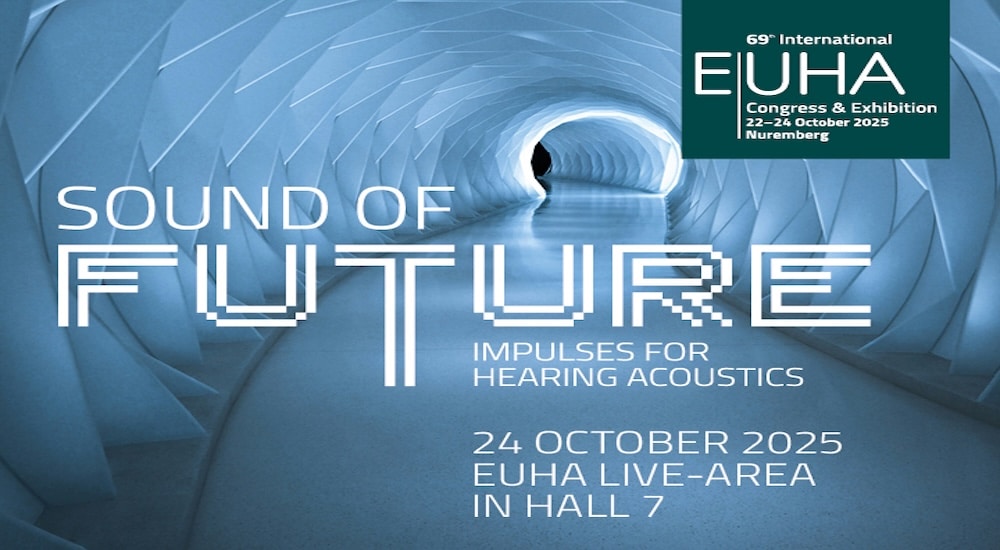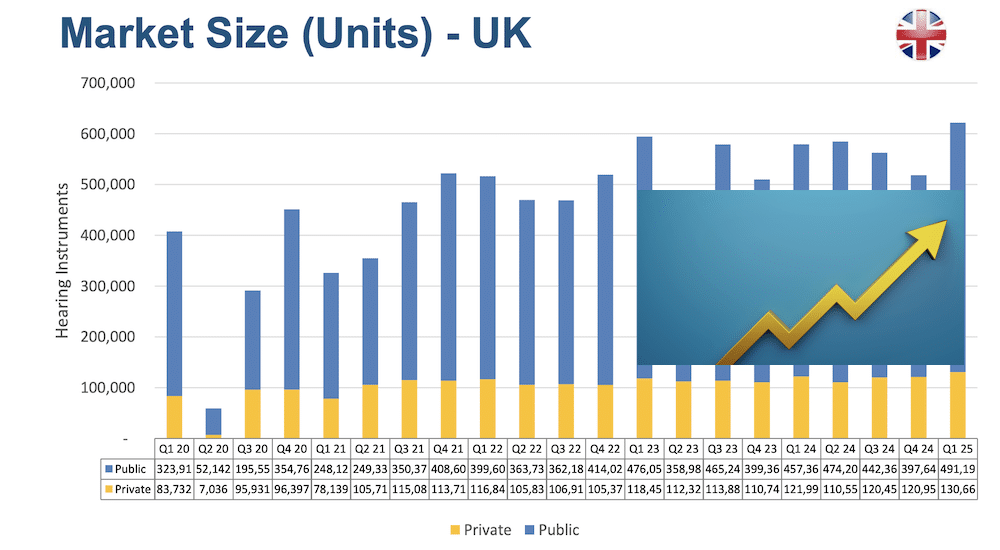"YOU’VE GOT TO DO WELL IN NOISE!"
Laurel Christensen, GN Hearing’s Chief Audiology Officer, is the perfect straight-talking envoy to explain the Danish producer’s new ReSound Nexia hearing aid. She told editor-in-chief Peter Wix about the device’s well-connected minuteness, and how she sees it standing tall in a world of OTC and AI.

Laurel Christensen is fun to talk to. Breezy au courant answers flow smoothly from her to every question. And in a sinuous drawl a UK journalist would be lucky to guess at being a Midwest North American accent, she dismisses as downright oxymoronic the idea that GN’s dinky, slinky, and highly linky new hearing aid, Nexia, might need to be sold sexier than other devices in an increasingly competitive health tech field.
Despite the lush advertising, cool colour schemes, and launch cries of “this is the best ever…”, hearing aids are not, for Laurel, going to be objects of sex appeal.
“Were they ever sexy? I think it’s very hard to make a hearing aid sexy,” she laughs. She recognises, though, that with each new aid of whatever brand, the superlatives an audiologist must cut through to get at the details require a mad eye and a mental buzzsaw. “Yeah, sometimes they [the marketers] go crazy, so it’s hard not to agree with you,” she concedes.
Christensen’s readiness to find amusement in certain marketing extremes does also suggest her sharp understanding of the hearing aid is, as one would expect, more based on what the audiologist needs tech to deliver than how what it delivers can be pitched.
© GN Hearing Laurel Christensen: “I think there’s a difference between technology for technology’s sake and technology that actually has an end user benefit, right?”
“You know I think there are times when when you are making a big leap and, and we’ve seen a lot of products through the years that have really changed the industry,” she adds.
With a nostalgic gleam in her eye, GN’s audiology honcho is recalling the open solutions of GN’s 2003 ReSound Air release, WDRC (Wide Dynamic Range Compression), directionality with a 4-microphone array, hitting the market with two beamformers, or being the first hearing company to release a “made for iPhone” device. Like every manufacturer, GN likes to introduce a first.
“It’s all about connectivity” – Auracast broadcast audio streaming capability
So what’s first with Nexia? Leading-edge connectivity is increasingly working its way to the front of features listed for hearing aids. Streaming and making hands-free calls by using Bluetooth Low Energy (LE) wireless technology is now, Christensen underlines, a must-have for hearing aids, but this new ReSound hearing aid is planting a flag in the ground as a device not only with LE but also ready for Auracast, the next generation of Bluetooth.
“Connectivity means a lot to people and this is going to change hearing aid users’ lives, and cochlear implant users’ lives,” she enthuses.
“Low power consumption really will change a lot about how we design hearing aids too, because we need low power consumption, so that’s Nexia; I think it’s a pretty good name, but I think there’s no doubt that this isn’t just incremental, it’s a big, big jump.”
Stressing the new product as “a lot about the future”, perhaps a 2027 when this expert’s sources suggest three billion low-energy devices in use, or a 2030 with 2.5m transmitters in public spaces, she nods and turns that flag in a foot more: “We’re pretty proud to be the first to have it in a hearing aid, and to have an Auracast product.”
Nexia will be released in the UK early in 2024, and that still seems years off those projected days of plenty. But does Laurel Christensen think that being Auracast-ready might be a little early to rouse the interest of audiologists and their patients?
Naming phone, TV, and computer manufacturers already setting up to work with LE audio – e.g. Samsung, Google, Qualcomm – GN’s audiology chief makes a key point about the kind of buy that hearing aids are.
“You know, hearing aids are not a purchase that are made every two years like a cell phone. These are five to six or even more years that people keep them, and by then for sure, you know, this is going to be, Auracaust is going to be, changing even someone like me whose normal hearing will be tapping into Auracast streams in bars, in exercise places, and museums,” she argues.
“We’re happy to have it in there because I think anything that doesn’t have it in there now is probably not doing a good service for people who are going to need it.”
A market of people that are not technically savvy, and growing for at least ten years
So, by that 2027-2030 timeframe Christensen mentions, does she think that digital natives will be arriving to the hearing aid market with much more ability to figure things out in an OTC world than today’s users? Her answer is a breeze of optimism for both professionals and the industry:
“We’re still meeting the needs of an elderly population that is still growing, I mean just growth in baby boomers continues.”
She mentions an expanding US market because of repeat hearing aid sales and managed care bringing in more and more people, “and insurance coverage is becoming more of a thing in the states, so you’ve got some growth on that.”
“I still think that for the foreseeable future, at least the next 10 years, we’re still going to be serving a population that for the most part isn’t as technically savvy,” she presages.
In hearing aids, small matters
On to smaller matters. Feedback gathered by GN had suggested that a lot of people did not like the size of their standard RIE, explained Christensen, and this prompted the release of GN’s mini styles.
“Ultimately we put out the mini. We were at that time already working on the micro because size, you know, it’s amazing how much it does matter to people.1I mean they just want to get something that is extremely discreet and cosmetic,” she, er, enlarges, but without hiding the great difficulty of not losing any features or power in what is a new rechargeable Nexia Micro RIE 25% smaller than the standard RIE.
“So, we’ve been able to put everything in this, I mean no compromise on the technical side, that was part of the deal.”
Is OTC really going to have an impact?
Deals and dealing, of course, are also what it’s all about. And while GN launches a new range in traditional hearing aids, the company’s current backdrop is also about having been lightning fast out of the blocks on product that races to a ribbon marked OTC. The group’s Jabra Enhance Plus was released in summer 2021, an “as and when” hearing solution in trendy earbud form, planned for sale through HCPs but with a bet-hedged readiness for approval from the US Food and Drug Administration to fall under self-fitting regulations, i.e. over-the-counter. It is now found as such, for example, on Amazon.
But Christensen sees no market blurring or competition between over-the-counter and traditional models. In fact, as far as the user is concerned, she sees both types as completely separate, and OTC as something that faces a more difficult fight to become established than many were predicting.
While she admits that “price pressure has been happening for a while, and there’s no doubt that price is coming down”, the OTC market “for sure today is not going anywhere. It has not taken off and and I think there are a lot of things that are going to have to happen for it to take off.”
Underlining that OTC “isn’t really changing our market here in the United States”, which is where it has been regulated, this expert was damning about the emerging OTC panorama: “I mean, it’s the wild, wild West. You’re faced with all of these products, all of these different price points. You don’t know which ones work, which ones don’t. You don’t even know what their connectivity to a phone is. And I’ve heard – it’s all rumour – but I’ve heard the return rates of these products are upward of 50%.”
For Christensen, the model that may stick – much in line with the way some companies, including GN, have been pitching their OTC product – is possibly “a hybrid where you might get the hearing aid but have the opportunity to have some sessions with a professional.”
But she is adamant about seeing no competition between OTC and the traditional hearing aid, such as Nexia. The first is all about mild-to-moderate loss and, for GN’s Chief Audiology Officer, that OTC buyer is a user that “is not coming into a shop, they’re just not.”
She continues: “I think they’re kind of separate groups of people who go in these different ways, and they’ll ultimately all end up in prescriptive hearing aids as they lose more and more hearing. But I don’t think they’re competitive.”
© GN Hearing Laurel Christensen on smallness: “It’s amazing how much it does matter to people”
“Even the really good products on the market are very low-gain OTC, and most people at some point are going to need a little bit more than that,” she adds, as we veer towards the essential problem of being able to hear in noise.
“To really succeed in the OTC market, you’ve got to have something that does incredibly well in noise.”
And it is in this crucial area, listening in noise, that Nexia is seen by Christensen as holding to a strength GN traditionally claims for its aids.
“If you look at us, we’ve made some really large improvements in hearing in noise. Our head of research started like 15 years ago on a research trajectory that ultimately took us to Omnia, and Omnia having really clearly the best hearing in noise in the industry, and demonstratable. And I would argue we have the best solution in noise out on the market.”
1 70%, according to GN’s own 2021 study Discreetness perceptions, GNH Qualitative & Quantitative Study.
2 https://www.audiology-worldnews.com/new-products2/4182-gn-announces-an-as-and-when-hearing-aid-earbud-jabra-enhance-plus.
Source: First published in Audiology News UK issue 05 November-December 2023







